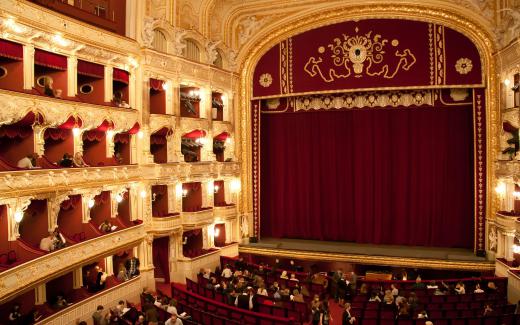Early Baroque Opera Story Lines Are Based on What Type of Art Form

Baroque opera refers to opera composed during the Bizarre era, a period in the artistic history of Europe. The Bizarre era is ordinarily regarded as encompassing the years between 1600 and 1750, post-obit the previous Renaissance menstruation and eventually giving way to the subsequent Classical period. The emergence of opera as a genre predates the beginning of the Baroque era by merely a few years, so Baroque opera encompasses the early evolution of opera and its development into an of import form of music.

Like later on opera, ane of the key features of Baroque opera is monody, music in which a solo vocaliser sings the melody of the song while other instruments provide accessory. Monody was an important development in Baroque music that distinguishes information technology from the polyphony-based vocal music of the Renaissance period, in which multiple singers sang different melodic lines simultaneously. The singer'due south instrumental accessory frequently incorporated a form of accessory called basso continuo. A low-pitched instrument or instruments, such as a cello, played a bass line while an instrument capable of playing chords, such as a harpsichord, played the notes of the bass line along with calculation additional, higher notes to play a consummate chord.

Baroque opera composers were likewise more specific in their compositions than previous creators of vocal music, specifying particular instruments or combinations of instruments intended to suit the emotional tone of each scene in the opera. Instrumentation became more elaborate and complex equally a result. The opera of the Baroque period was followed by the opera of the subsequent Classical menstruation, which spanned the years from about 1750 to 1830. In contrast to Baroque music, Classical opera's instrumentation tended to be less complex and ornamented, and music of the Classical period placed more emphasis on dramatic changes and contrasts within a unmarried slice.
Bizarre opera developed from a number of influences, both musical and non-musical. Early on opera arose in the concluding years of the 16th century out of an existing tradition of Italian vocal music in which one singer sang the chief melody while other singers or musicians provided supporting accompaniment. Multiple songs could be performed in succession with lyrics that told a continuing story. At the aforementioned time, the increased interest in Classical Greek and Roman literature during the Renaissance led to an interest in reviving classical Greek drama, which incorporated musical elements. Theatrical performances that included musical performances betwixt the acts of a play were also growing in popularity during the 16th century. The great wealth of the Italian nobleman who funded these events meant that they were often very large, grandiose spectacles.
The showtime limerick generally agreed to be an opera, entitled Dafne, was composed by Jacopo Peri in 1597, on the cusp of the Bizarre era. The first composer of Bizarre opera whose piece of work is however commonly performed today was Claudio Monteverdi, who composed his starting time opera, 50'Orfeo, in 1607. As was typical for Italian music of the Renaissance era in which Monteverdi'south career had begun, the instrumental parts of the music were partly improvised by the musicians for each performance rather than fully scored in advance, which distinguishes Monteverdi from later Bizarre operas. Different Peri'south operas, which were relatively small-scale-calibration performances with merely a handful of accompanying instruments, L'Orfeo was intended to be performed by nearly forty musicians accompanying the vocalists, with detail groups of instruments designated for different characters and scenes. In addition, Monteverdi utilized many musical techniques that would be enormously of import for the future evolution of Bizarre opera.
The next few decades saw the new art form grow in popularity until information technology had spread across noble courts and formal public events to become a form of pop entertainment. It likewise spread beyond Italy, leading to the composition of operas in languages such as French, German, and English language. Baroque opera composers whose work is still widely performed today include Antonio Vivaldi, George Frideric Handel, and Jean-Philippe Rameau.
Source: https://www.musicalexpert.org/what-is-baroque-opera.htm
0 Response to "Early Baroque Opera Story Lines Are Based on What Type of Art Form"
Post a Comment